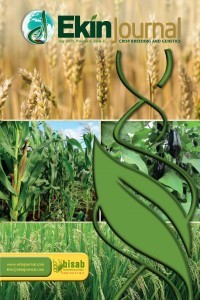Comparative Performance of Triticale Genotypes in North Wes tern Plain Zone of India for Grain Yield and its Attributes
Comparative Performance of Triticale Genotypes in North Wes tern Plain Zone of India for Grain Yield and its Attributes
triticale grain yield, diseases reaction, abiotics tress,
___
- Ammar K, Mergoum M and Rajaram S (2004). The his tory and evolution of triticale in Triticale Improvement and Production(ed. by Mergoun M, Gomez-Macpherson H.). Food and Agriculture Organization of the United Nations, Rome, pp: 1-10.
- Anonymous (2013). http://www.fao.org/faostat/en/#-data/QC
- Anonymous (2014). Progress report of All India Coordinated Wheat & Barley Improvement Project 2013-14, vol. I, Crop Improvement. pp: 210-213.
- Jindal Y, Kumari P, Tokas J, Pahuja SK and Bishnoi OP (2017). Evaluation of high nutritive fodder Triticale (x TriticosecaleWittmack) vis-a-vis rabi fodder crops in semi arid region of North West Haryana in India. Abstract published in International Conference on Triticale Biology, Breeding and Production, Poland from July, 2-5. pp:-37.
- Kaur H, Mavi GS, Singh B and Sohu VS (2007). Screening for qualitative traits and grain iron-zinc mass concentrations in triticale (xTriticosecale) at different environments. Abstract published in International Conference on Triticale Biology, Breeding and Production, Poland from July, 2-5. pp:-18.
- Megoum M, Singh PK, Pena RJ, Lozano-del Rio AJ, Cooper KV, Salmon DF and Macpherson HG (2009). Triticale: A New Crop with Old Challenges. Cereals. Springer US. pp: 267-287.
- Sharma KD, Bishnoi OP and Behl RK (2017). Comparative evaluation of root characteristics, physiological functions and grain yield in triticale and wheat species. Abstract published in International Conference on Triticale Biology, Breeding and Production, Poland from July, 2-5. pp:-29.
- Suresh, Bishnoi OP and Behl RK (2018). Use of Heat Susceptibility Index and Heat Response Index as a Measure of Heat Tolerance in Wheat and Triticale. Ekin Journal of Crop Breeding and Genetics,4(2): 39-44.
- Vats AK, Dhanda SS, Munjal R, Bishnoi OP and Behl RK (2016). Nutrient Use and Uptake Efficiency in Wheat and Triticale Genotypes under Low and Optimum Input Conditions. Ekin Journal of Crop Breeding and Genetics, 2(2): 95-100.
- Wilson A (1875). On wheat and rye hybrids. Trans Proc Bot Soc., 12: 286-288.
- Zurek M, Warzecha R, Ochodzki P and Grzeszczak I (2017). Triticale for grain and biomass under organic farming in Poland. Abstract published in International Conference on Triticale Biology, Breeding and Production, Poland from July, 2-5. pp:-53.
- ISSN: 2149-1275
- Yayın Aralığı: Yılda 2 Sayı
- Başlangıç: 2015
- Yayıncı: Bitki Islahçıları Alt Birliği
Potential of Trakya Region for Production of Triticale
İsmet BASER, Zahit Kayihan KORKUT, Alpay BALKAN, Oguz BILGIN
Prospects of Advanced Genomics for Development of Climate Resilient Wheat Genotypes
Surender KHATODIA, Kirti BHATOTIA, Rishi K. BEHL
Emel OZER, Nurcan Akay GURBUZ, Nurdilek GULMEZOGLU
İsmet BASER, Zahit Kayihan KORKUT, Alpay BALKAN, Levent OZDUVEN, Oguz BILGIN
Evaluation of Yield and Some Agro-Morphological Characters of Triticale Genotypes in Trakya Region
İrfan OZTURK, Turhan KAHRAMAN, Remzi AVCI, Sahinde SILI, Tugba Hilal KILIC, Adnan TULEK
Zinnur GOZUBUYUK, Okan DEMIR, Ahmet KUCUKOZDEMIR
